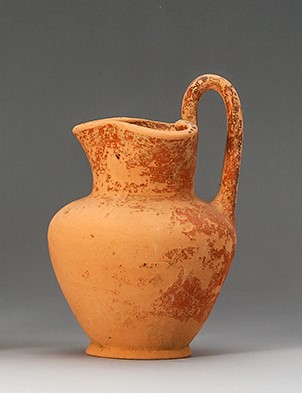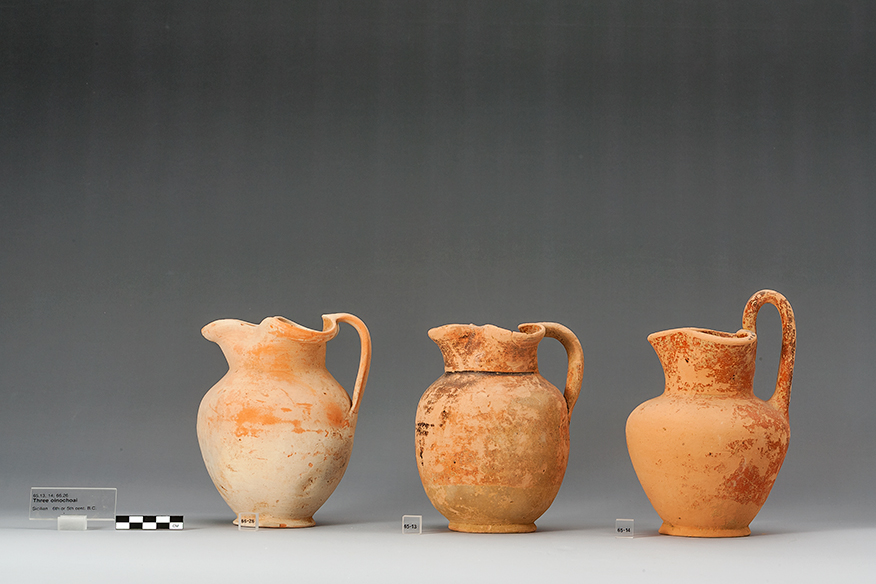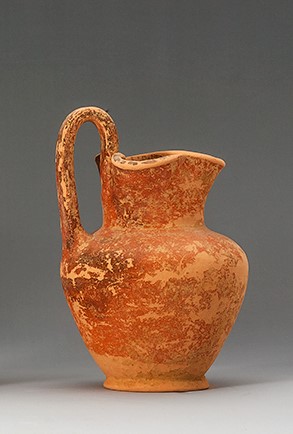Title: Sicilian Oinochoe - 1965.14
Acquisition number: 1965.14
Acquisition source or name: Sotheby’s London
Acquisition year: 1965
Owner type: ANU Classics Museum
Author or editor: J.R. Green
Culture or period: Sicilian Black, Banded and Plain.
Date: 6th - 5th century BC.
Date century or Timeline (notional): 599 to 400
Material: Clay - Terracotta
Object type: Vessels - Jug/wine jug
Dimensions: 118mm (w) × 156mm (h)
Origin region or location: Italy
Origin city: Sicily.
Display case or on loan: 10
Collection history: Purchase
Keywords: Sicilian
Sotheby (London), Sale Cat., 17 May 1965, no. 166; J.R. Green with B. Rawson, Catalogue of Antiquities in the Australian National University, A.N.U. (Canberra, 1981) 70.
1965.14
Sicilian Oinochoe
Purchased. Ht (lip) 15.6cm; diam.11.8cm.
Pinkish buff clay; brown to black paint, worn. The inside of the lip is painted as is all the outside to the lower wall. There is no wash inside; the underside is reserved.
Compare 1965.13 and 1966.26.
These three trefoil-mouthed oinochoai are of a common Sicilian type found at many sites of the sixth and fifth centuries BC. It would be hazardous to attempt to date them with any precision but the relative sequence of the three may be judged by the way in which the mouth is formed. 1965.13 is the earliest with upright mouth pulled in only a little at the sides to form the spout. In 1965.14 it is more fully modelled but not so much as that of 1966.26 where the inner corners are pulled in and over, and the lip is out-turned. Note also the differing forms of the handle and of the body.
Compare Insediamenti coloniali greci in Sicilia nell’ VIII e VII secolo a.C. (Catania 1980) pl. 6, for seventh-century versions; NSc 1954, 402 fig. 11 (Megara Hyblaea) from a tomb of the later seventh century; Notizie degli Scavi di Antichità, Accademia Nazionale dei Lincei 1954, 143 fig. 15 (Paternò) for a number of jugs of this type not individually dated; Notizie degli Scavi di Antichità, Accademia Nazionale dei Lincei 1961, 205 fig. 7 and 214 fig.18 (Calascibetta) for large quantities of such jugs datable to the sixth century.
Sotheby (London), Sale Cat., 17 May 1965, no. 166; J.R. Green with B. Rawson, Catalogue of Antiquities in the Australian National University, A.N.U. (Canberra, 1981) 70.
1965.14
Three Sicilian oinochoai (wine jugs)
6th or 5th century BC
Sotheby’s London 17/5/65; lot 166.


